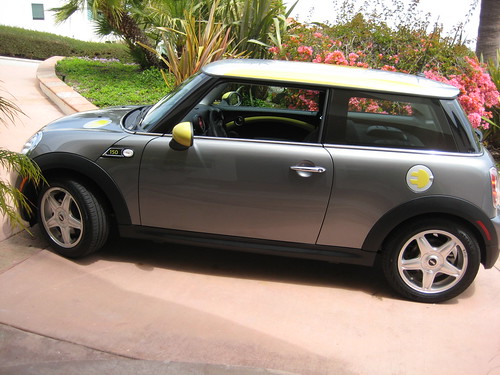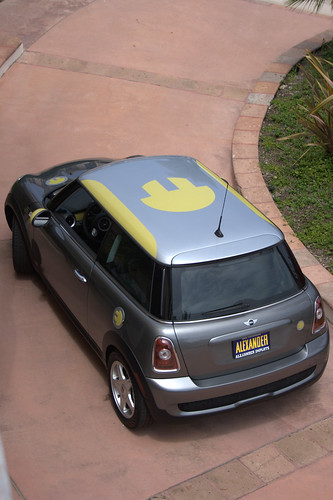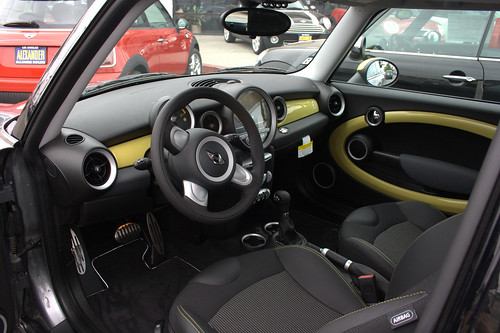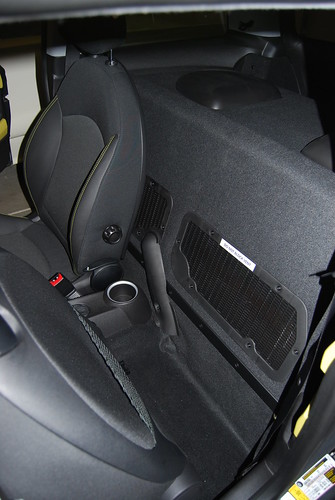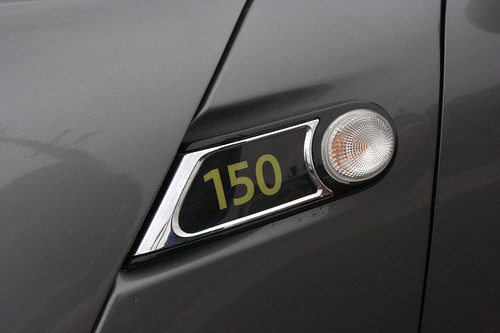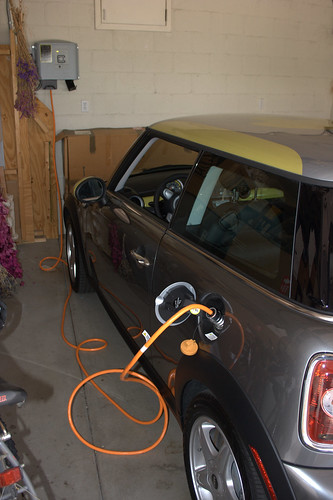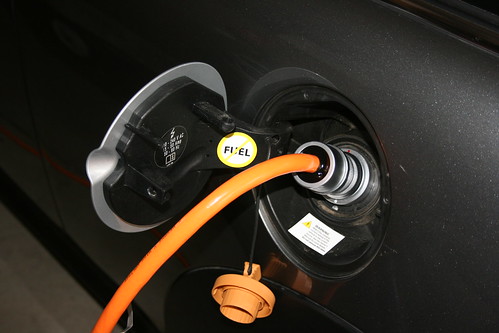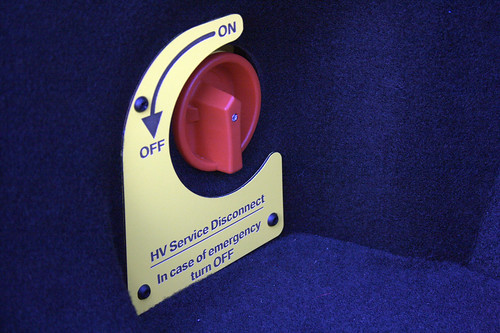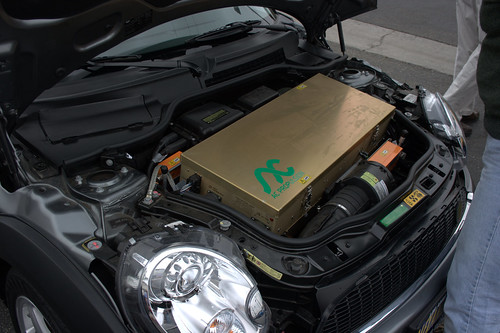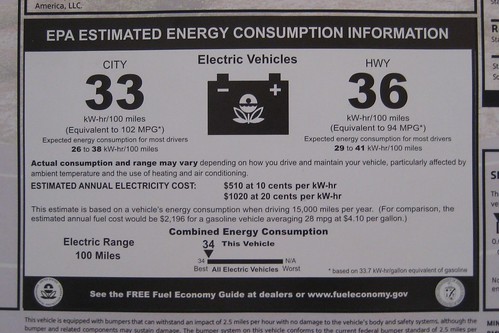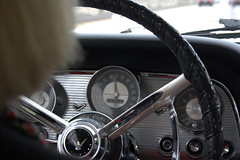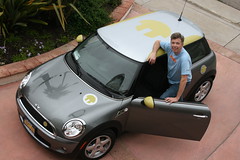
Me and the Mini-e
After my trip to the Taco Bell headquarters and test kitchen in Irvine, CA, I went to visit my sister in Los Angeles and while I was there she and her husband took delivery of their new Mini-e (All-Electric Mini Cooper)...one of the first to be delivered. So then my mission became a review of the Mini-e. Here it is...
| Contents: |
|
The Mini-e is in a 'field trial' in the US. It is an all-electric car. It has the same body as a Mini Cooper S. People were invited to apply for one. Well, actually, for a 1-year lease. My sister and her husband applied and recieved one of the first ones to be delivered in LA. (They are only availalbe in the LA and New York areas.) At the end of the year the car will have to go back to Mini Cooper for evaluation.
We picked up the Mini-e at Alexander Mini in LA on Saturday, May 30, 2009.
Here are a few body shots (clicking on any images here will take you to the Flickr photo page, part of my Mini-e photo set):
As you can see, there are plenty of distinctive markings to identify it as a Mini-e. There's an additional logo for the sides (that is seen in most press photos) which is optional.
The body color and interior colors are distinctive to the Mini-e. Here's the interior.
The back seat is taken up by the batteries. Here's a look behind the driver's seat:
Each Mini-e has a unique number on the body (on each side between the door and the hood). This one is #150. We were told by the dealership that 007 was, of course, highly sought after!
Official details about the Mini-e can be found at the official Mini-e web site (here's the .pdf spec sheet), but what I write here is information gleaned from reps at the Mini dealer and personal experience.
Let's start with the fun stuff. I shouldn't be surprised, I've read about the Tesla, but this thing moves. It isn't so much its 0-60 (officially 8.6 seconds) or its top speed (officially 95 mph), but that no matter how fast you're going on any hill, if you give it gas, it instantly accelerates.
I think another thing that makes it seem fast is that the engine sounds that you're used to hearing when you floor a car aren't there. My brain expects that typical straining sound of an internal combustion engine when I press the pedal to the floor, but you don't get that with the Mini-e... just speed. There is a little electric engine 'whine', but that certainly isn't the same thing.
And here's the first possible drawback... when you do floor it, it starts to feel like you could lose control. The slightest movement of the steering wheel at maximum acceleration feels like the car is going to veer wildly off course. But that's why this is a field test. BMW will be working out the kinks before this car comes to market.
The Mini-e's top speed of 95 mph is because of a governor (or, "electric cut-off"), but I didn't push it much past the speed limit on PCH anyway... that's where Ferraris get split in half! I'll ask my brother-in-law (who loves his motorcycle) about top speed later, after he's had a chance to let it loose. (Actually, he did compare the Mini-e's feeling of acceleration to that of his motorcycle.)
You can get a sense of the acceleration, among other things, in the videos later in this review.
Here is the most distinctive characteristic of driving the Mini-e: when you take your foot off the gas the car immediately and dramatically begins to slow down.
This is BMWís technique for getting the maximum re-charge for the battery while driving.
It is the first and last thing the Mini Cooper reps tell you about before you get behind the wheel of a Mini-e.
The decrease in speed when you take your foot off the gas is so dramatic, in fact, that the brake lights come on as you start to slow down even though you're not using the brake.
In regular driving, you will rarely use the brakes except for coming to a complete stop or a really quick stop.
When you would normally take your foot off the gas to coast as traffic slows ahead, you have to continue to press the accelerator to achieve this same effect.
It is certainly something that you have to get used to, but not something you canít get used to. And you can see the effect by watching the charge meter on the speedometer as the car slows.
Coming to a stop when going up a hill
As I mentioned, you donít need to use the brake at all when you want to come to a stop at a stop sign when your headed up an incline.
BUT, once you come to a complete stop at the stop sign, the Mini-e only holds you there for 2 seconds and then suddenly it starts to free-roll back down the hill. Thatís when you definitely need to use the brakeÖ not to stop, but to keep it from rolling backwards.I discovered this when I almost rolled backwards into a Prius (of all things). It is only common sense that youíd need to use the brake to hold it on a hill, but after awhile you get so used to not using the brake on flat terrain that you forget about it when you later find yourself going up a hill and come to a stop sign.
Backing up a bit, before my sister & her husband got their Mini-e, electricians came out to their house to see if they had sufficient amperage/wiring for the charging station. Then the Mini folks installed the Clipper Creek charging station:
And here's the Mini-e plugged in and charging:
The charging station will fully charge the carís batteries over night. If you donít make it back to your charging station or want to charge somewhere else, you can use a different cable and charge it from a regular 110 outlet. A full charge like this, from a regular outlet, would take 26 hours. (Note: the dealer did not have the 110-volt, regular household outlet cable when they picked up the car. It will be supplied later.) As soon as it is plugged into the charging station a fan can be heard running under the rear of the car. It is pretty faint.
Our experience over the weekend was that the Mini-eís batteries got a lot of charge in a short time from the charging station. In a couple hours it went from a 35% charge to an 95% charge.
Iíve heard range estimates (when fully charged) of 90 to 150 miles. My sisterís commute is 45 miles round-trip, so it will be perfect for that.
Oh, by the way, in case you might forget that your all-electric Mini Cooper doesn't need any gas at all, Mini has included a handy and hilarious "no fuel" sticker next to the plug-in:
There is a switch in the 'trunk' labeled "HV Service Disconnect." As my brother-in-law said, "This is what emergency responders would switch off before using the jaws of life to get you out of the car after an accident so they don't get a shock." He also said that he was told that fire departments in the LA area had been sent information on identifying the car and the location of this switch.
Charge Status / Battery Usage:
The main dial behind the steering wheel shows the current level of charge in a 0% to 100% range.
A small digital screen at the bottom of this dial can show various information. One setting shows the estimated range in miles with the current charge level.
Hereís a video of the dashboard when the Mini-e is turned on. It shows this dial quickly move from 0 to 100% when the ĎStartí button is pressed (because it was fully charged when I filmed it. (Like other Mini Coopers, the large dial in the center of the dash is the speedometer.
Unlike the Prius, with its large, graphic intensive screen to display engine and battery usage and battery status, the Mini-e has a small half circle of orange LEDs on the right side of the speedometer that indicate whether you are using or charging the battery.
When you are accelerating, and therefore draining the cars battery, the LEDs at the 9 oíclock position and above light up. When you are coasting (remember, when you take your foot off the gas the Mini-e immediately begins to slow down, thus charging the battery) or braking, the LEDís at and below the 9 oíclock position light up.
In this video (and I apologize in advance for the poor quality) youíll first see the LEDs below the 9 oíclock position lit because my wife has taken her foot off the gas, the car is slowing down, and using the momentum to charge the battery. Then, when she starts to accelerate the LEDs above the 9 oíclock position begin to light up.
Iím going to have to let the pictures convey everything here. I donít pretend to understand what Iím seeing under the hood. The Mini Cooper spec sheet calls it an AC Induction Motor:
This video is of my wife, Cara, driving the Mini-e from a residential street onto PCH (Pacific Coast Highway 1 in California). She demonstrates slowing down without using the brake. (The odd up and down moment is when she goes over a speed bump.) Youíll get to hear what the acceleration sound is like as she pulls onto PCH.
This second video is of me driving the Mini-e. Cara is filming. She zooms in on the aforementioned power use gauge that shows whether you are using or charging the battery. Then youíll see out the front window as I accelerate down the street. I do use the brake when coming to this stop sign, probably because I was going too fast and waited too long to let the car do the slowing down for me.
You can view the entire window sticker on Flickr. The MSRP for the Mini-e is $49.990, but remember, it is not for sale. It is currently only available on a 1 year lease.
But the most interesting part of the window sticker is the "EPA Estimated Energy Consumption Information." When I first glanced at it, I was confused, seeing a big 33 and a big 36. I was accustomed to these numbers representing average highway and city MPG, and those numbers seemed inappropriate for an all-electric car. And they are! The EPA has a new system for all-electric cars: kW-hr/100 miles. It states that the 36 kW-hr/100 miles for highway driving is equivelent to 94 MPG. The have estimated annual costs, too, but that's difficult to estimate given usage and electricity cost variables.
- The Mini-e seats 2. There is no back seat. That's where the battery is. There is a small trunk area; room for a couple bags of groceries.
- The shifter (on the floor between the seats) has 4 positions: P, N, D, and R.
- BMW has made an effort to make the Mini-e as 'normal' and as similar to a regular internal combusion Mini Cooper as possible. An example is my comparison, above, to the large status screen on a Prius versus the small half-circle of LEDs on the Mini-e.
- "Mini-e" is Mini Cooper's prefered name for the car, although at the outset we also found ourselves calling it the e-Mini and the Green Mini. (The later didn't work well at all since my niece has a regular Mini Cooper that is green in color and that made it hard to know which Mini we were talking about.)
The Mini-e is a blast to drive.
There are a couple things to get used to: the immediate slow-down when you take your foot off the gas and rolling backwards on an incline. But they are no more difficult to get used to than switching from driving a car with automatic transmission to one with a standard transmission.
You aren't going on any road trips in this car. Actually, you're not going anywhere more than about 70 miles away. With a ~150 mile range and a 20+ hour charge time on a regular 110 volt outlet it would make for a very slow trip across the country. The 2 person capacity and minimal storage area are notable limits as well, but it is a perfect second car to be used for your daily commute.
BMW/Mini will learn a lot more about this prototype by leasing it to 500 real families than they could on a test track. A very smart move. It will help them immensely in bringing the final version to market. And hopefully in that time battery capacity will increase and size will decrease.
BMW/Mini was also smart to put the electric motor and batteries in a standard Mini-Cooper S body. It is a popular and established look. I've heard several people comment on the ugliness of the Prius and that Toyota would have been smarter to put their first hybrid engine in an established model like the Corolla or Camry.
My 77 year-old dad was profoundly impressed with this car. After he got back from his first time driving the Mini-e he got out of it and said, "This is the car of the future."
Several friends and family drove Mini-e #150 during its first weekend in LA and each of them got out of the car with wide eyes and a big smile.
In short, I'm pretty damn jealous of my sister for having this car. I wish I lived in LA so I could drive it more often (or lease my own). I look forward to the day when the Mini-e is available for purchase everywhere.
I have to show you this, too, the car we drove to pick up the Mini-e. My sister's 1958 Ford Thunderbird. Yes, it is a cool car, but what's really fun is the dichotomy of driving a Detroit gas guzzler to pick up a zero-emmision all-electric car. (There are are some more (artsy) pics of the Thunderbird in my Mini-e Flickr photo set.)
Thanks for reading... I hope you enjoyed it (almost) as much as I enjoyed my weekend driving the Mini-e. |
